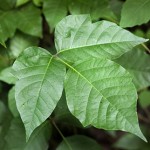Leaves of Three…
Leaves of Three… …let it be, as the expression goes. If you’ve never heard this before, now’s your time to learn. And this lesson couldn’t come at a better time.
Traditionally, “leaves of three” is referring to poison ivy, that somewhat difficult-to-recognize plant that can cause a whole lot of grief for a good portion of the population. I say a good portion because, in fact, not everyone reacts to the chemical in the plant.
However, you should most definitely treat it as if you do. Why? Because the chemical can actually stay on your skin, clothes, shoes, and your pet’s fur and paws. That means that you can transfer the chemical to anyone you touch, if you have skin-to-skin contact where the chemical is sitting.
Identifying the Plant
Look for a plant with whose stem ends with three pointed leaves. Leaves will have notches in the sides.
Sort of like this:
A young plant will be small, just tall enough to brush the top of your foot if you walk through with sandals. Mature plants will develop into a small shrub or a vine. Vines can be trailing (running along the ground) or climbing (winding up trees).
In the early spring, the leaves are a deep red colour; in the fall, they turn a mottled yellow and bright red.
The Effects
Touching a poison ivy plant may lead to nothing at all but most people react fairly negatively. The most common symptom are small bumps, similar to chicken pox usually in a linear pattern where the chemical from the plant brushed against the skin. The bumps quickly develop into small blisters and, in some cases, develop into very large blisters.
Best to just avoid this one.
Treatment
Treatment will depend on the severity of the rash. Calamine lotion will sooth the itching/burning sensation and for many, this will be the end of the story. There are other topical creams and lotions that can be applied and most can be purchased over the counter at your local drug store. Cold compresses, I find, work wonders.
For the severe reactions, a trip to the doctor is advised – it may be an allergic reaction to the chemical that will heal best with prescribed medication.
Leaves of three…
Poison oak also falls into this category, but poison sumac doesn’t. Both result in similar reactions: with some people not reacting at all and others requiring medical aid.
Before camping and other outdoor adventures (with or without the kids), take a look through this website, aptly called The Poison Ivy, Poison Oak, Poison Sumac Site.
Familiarize yourself with the three plants: what they look like, where you’ll find them, how to avoid them, and a good deal more. If you’re brave enough, you can even take a look through their “Skin Rash Hall of Fame”. Definitely not something I will be perusing.




